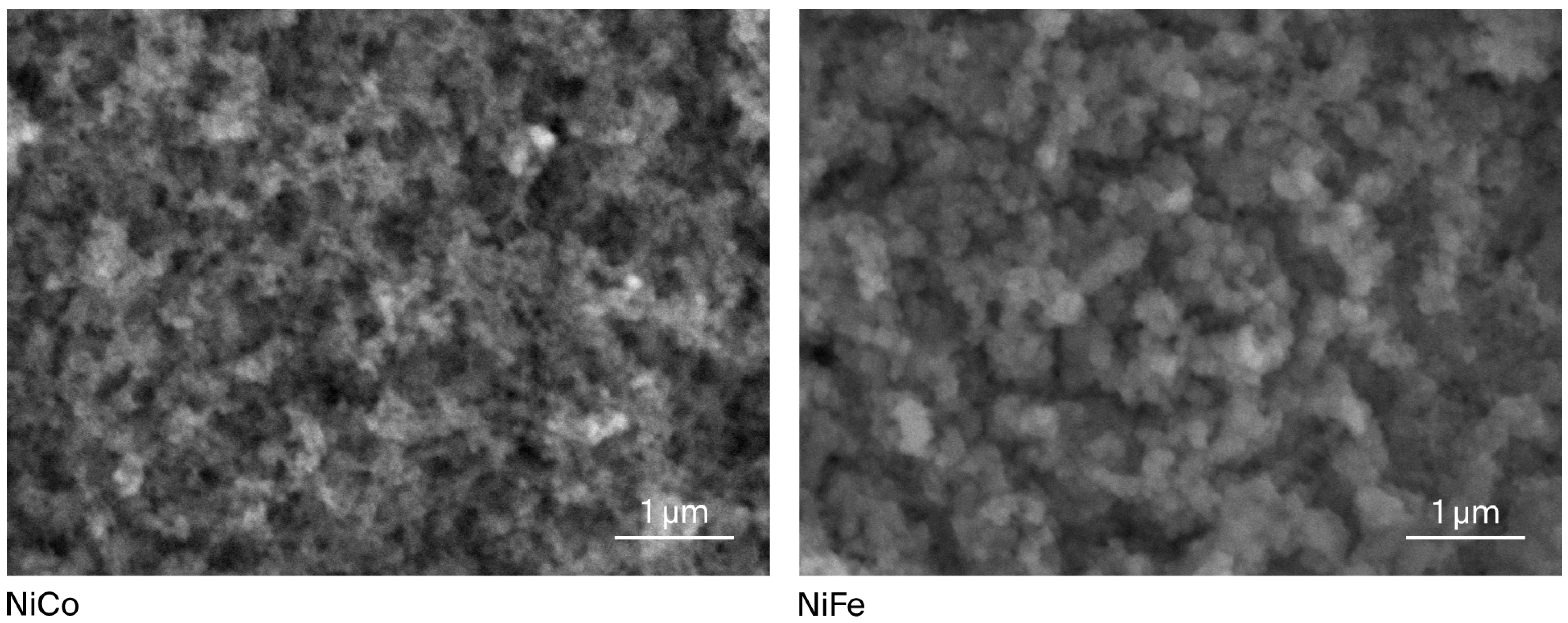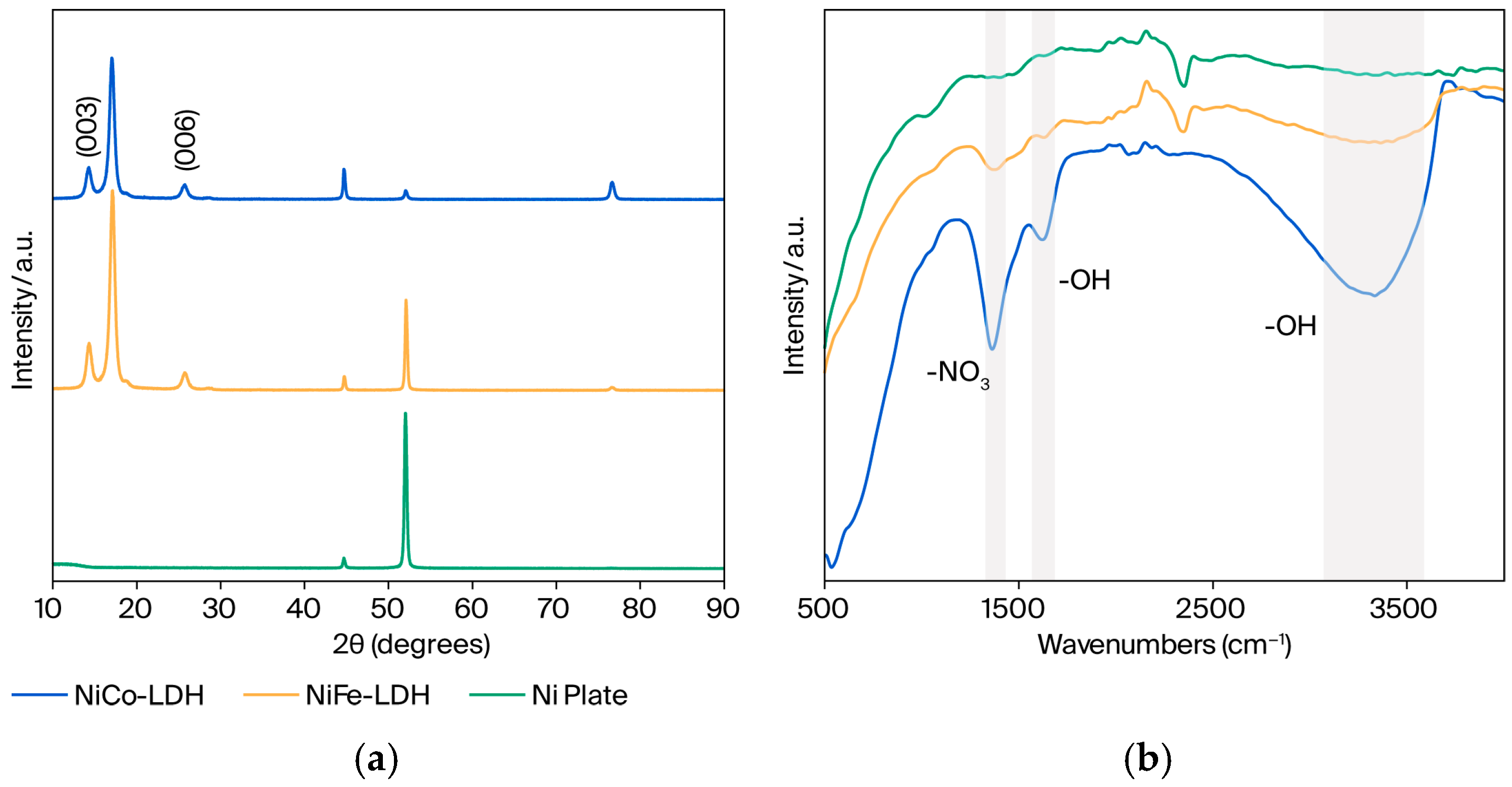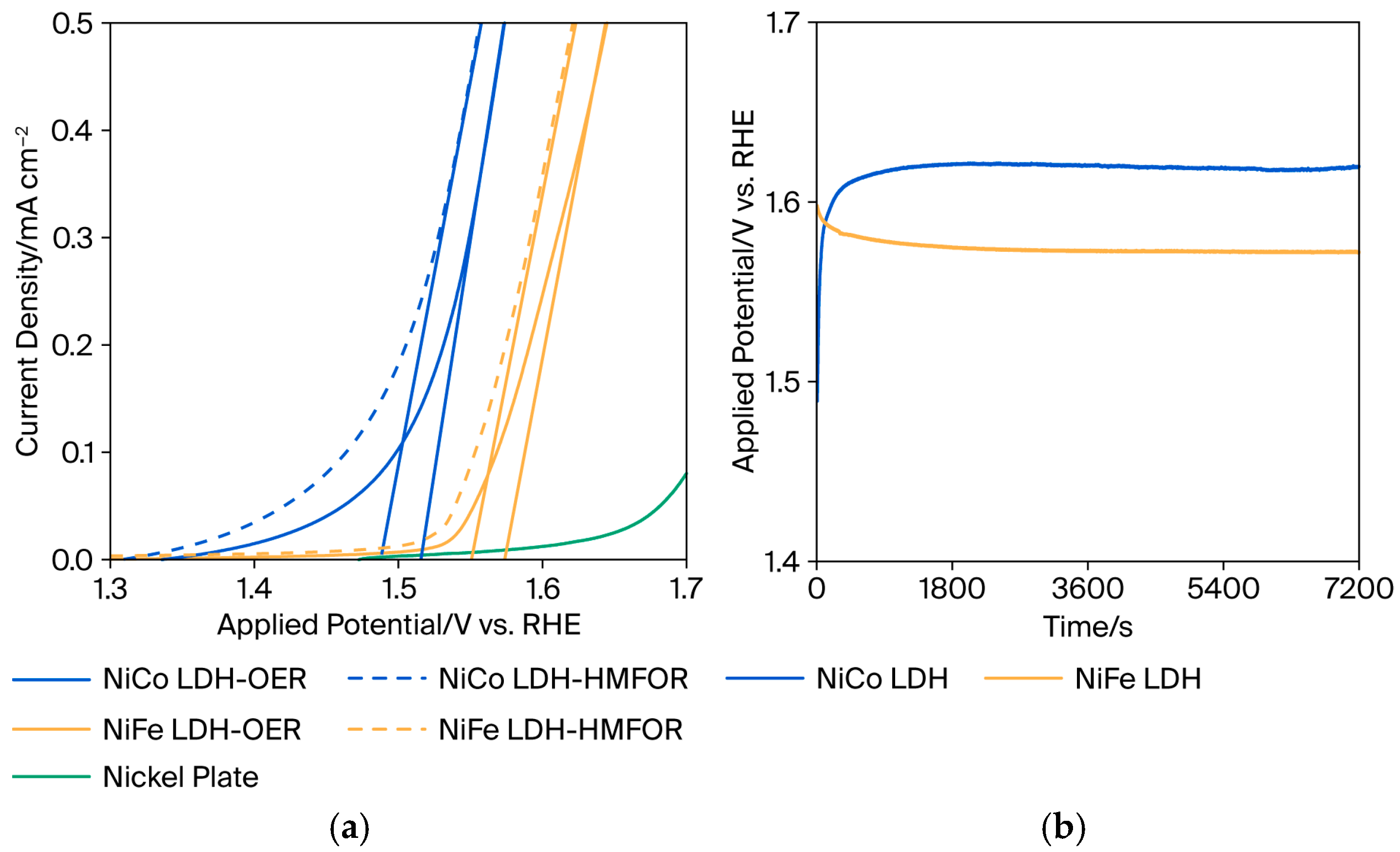Electrodeposition of Nickel-Based Thin Layered Double Hydroxides Electrocatalyst for 2,5-Diformylfuran Production †
Abstract
1. Introduction
2. Materials and Methods
2.1. Materials and Reagents
2.2. Synthesis and Characterization of NiCo-LDHs and NiFe-LDHs
2.3. Electrochemical Measurement
2.4. Product Analysis
3. Result and Discussion
3.1. Material Characterization
3.2. Electrochemical Characterization
3.3. DFF Product Analysis
4. Conclusions
Supplementary Materials
Author Contributions
Funding
Institutional Review Board Statement
Informed Consent Statement
Data Availability Statement
Conflicts of Interest
References
- Chen, Z.; Liao, S.; Ge, L.; Amaniampong, P.N.; Min, Y.; Wang, C.; Li, K.; Lee, J.-M. Reduced graphene oxide with controllably intimate bifunctionality for the catalytic transformation of fructose into 2, 5-diformylfuran in biphasic solvent systems. Chem. Eng. J. 2020, 379, 122284. [Google Scholar] [CrossRef]
- Qi, H.; Liu, F.; Zhang, L.; Li, L.; Su, Y.; Yang, J.; Hao, R.; Wang, A.; Zhang, T. Modulating trans-imination and hydrogenation towards the highly selective production of primary diamines from dialdehydes. Green Chem. 2020, 22, 6897–6901. [Google Scholar] [CrossRef]
- Silbert, S.D.; Serum, E.M.; LaScala, J.; Sibi, M.P.; Webster, D.C. Biobased, nonisocyanate, 2K polyurethane coatings produced from polycarbamate and dialdehyde cross-linking. ACS Sustain. Chem. Eng. 2019, 7, 19621–19630. [Google Scholar] [CrossRef]
- Zhao, D.; Su, T.; Wang, Y.; Varma, R.S.; Len, C. Recent advances in catalytic oxidation of 5-hydroxymethylfurfural. Mol. Catal. 2020, 495, 111133. [Google Scholar] [CrossRef]
- Gidi, L.; Amalraj, J.; Tenreiro, C.; Ramirez, G. Recent progress, trends, and new challenges in the electrochemical production of green hydrogen coupled to selective electrooxidation of 5-hydroxymethylfurfural (HMF). RSC Adv. 2023, 13, 28307–28336. [Google Scholar] [CrossRef]
- Guo, L.; Zhang, X.; Gan, L.; Pan, L.; Shi, C.; Huang, Z.F.; Zhang, X.; Zou, J.J. Advances in Selective Electrochemical Oxidation of 5-Hydroxymethylfurfural to Produce High-Value Chemicals. Adv. Sci. 2023, 10, e2205540. [Google Scholar] [CrossRef]
- Wan, Y.; Lee, J.-M. Toward value-added dicarboxylic acids from biomass derivatives via thermocatalytic conversion. ACS Catal. 2021, 11, 2524–2560. [Google Scholar] [CrossRef]
- Zhao, J.; Chen, X.; Du, Y.; Yang, Y.; Lee, J.-M. Vanadium-embedded mesoporous carbon microspheres as effective catalysts for selective aerobic oxidation of 5-hydroxymethyl-2-furfural into 2, 5-diformylfuran. Appl. Catal. A Gen. 2018, 568, 16–22. [Google Scholar] [CrossRef]
- Zhou, W.; Kong, Z.; Wu, Z.; Yang, S.; Wang, Y.; Liu, Y. Efficient oxidation of biomass derived 5-hydroxymethylfurfural into 2,5-diformylfuran catalyzed by NiMn layered double hydroxide. Catal. Commun. 2021, 151, 106279. [Google Scholar] [CrossRef]
- Neaţu, F.; Petrea, N.; Petre, R.; Somoghi, V.; Florea, M.; Parvulescu, V.I. Oxidation of 5-hydroxymethyl furfural to 2,5-diformylfuran in aqueous media over heterogeneous manganese based catalysts. Catal. Today 2016, 278, 66–73. [Google Scholar] [CrossRef]
- Simoska, O.; Rhodes, Z.; Weliwatte, S.; Cabrera-Pardo, J.R.; Gaffney, E.M.; Lim, K.; Minteer, S.D. Advances in Electrochemical Modification Strategies of 5-Hydroxymethylfurfural. ChemSusChem 2021, 14, 1674–1686. [Google Scholar] [CrossRef] [PubMed]
- Kwon, Y.; Schouten, K.J.P.; van der Waal, J.C.; de Jong, E.; Koper, M.T.M. Electrocatalytic Conversion of Furanic Compounds. ACS Catal. 2016, 6, 6704–6717. [Google Scholar] [CrossRef]
- Sun, H.; Xu, X.; Fei, L.; Zhou, W.; Shao, Z. Electrochemical Oxidation of Small Molecules for Energy-Saving Hydrogen Production. Adv. Energy Mater. 2024, 14, 2401242. [Google Scholar] [CrossRef]
- Du, L.; Sun, Y.; You, B. Hybrid water electrolysis: Replacing oxygen evolution reaction for energy-efficient hydrogen production and beyond. Mater. Rep. Energy 2021, 1, 100004. [Google Scholar] [CrossRef]
- Vuyyuru, K.R.; Strasser, P. Oxidation of biomass derived 5-hydroxymethylfurfural using heterogeneous and electrochemical catalysis. Catal. Today 2012, 195, 144–154. [Google Scholar] [CrossRef]
- Cao, T.; Wu, M.; Ordomsky, V.V.; Xin, X.; Wang, H.; Métivier, P.; Pera-Titus, M. Selective Electrogenerative Oxidation of 5-Hydroxymethylfurfural to 2,5-Furandialdehyde. ChemSusChem 2017, 10, 4851–4854. [Google Scholar] [CrossRef]
- Kubota, S.R.; Choi, K.S. Electrochemical Oxidation of 5-Hydroxymethylfurfural to 2,5-Furandicarboxylic Acid (FDCA) in Acidic Media Enabling Spontaneous FDCA Separation. ChemSusChem 2018, 11, 2138–2145. [Google Scholar] [CrossRef]
- Latsuzbaia, R.; Bisselink, R.; Anastasopol, A.; van der Meer, H.; van Heck, R.; Yagüe, M.S.; Zijlstra, M.; Roelands, M.; Crockatt, M.; Goetheer, E.; et al. Continuous electrochemical oxidation of biomass derived 5-(hydroxymethyl)furfural into 2,5-furandicarboxylic acid. J. Appl. Electrochem. 2018, 48, 611–626. [Google Scholar] [CrossRef]
- Ge, R.; Wang, Y.; Li, Z.; Xu, M.; Xu, S.-M.; Zhou, H.; Ji, K.; Chen, F.; Zhou, J.; Duan, H. Selective Electrooxidation of Biomass-Derived Alcohols to Aldehydes in a Neutral Medium: Promoted Water Dissociation over a Nickel-Oxide-Supported Ruthenium Single-Atom Catalyst. Angew. Chem. Int. Ed. 2022, 61, e202200211. [Google Scholar] [CrossRef] [PubMed]
- Le, T.-H.-H.; Vo, T.-G.; Chiang, C.-Y. Highly efficient amorphous binary cobalt-cerium metal oxides for selective oxidation of 5-hydroxymethylfurfural to 2,5-diformylfuran. J. Catal. 2021, 404, 560–569. [Google Scholar] [CrossRef]
- Mumtazah, N.; Chan, C.-H.; Catherine, S.; Pham, M.-T.H.; Choi, J.; Yoo, J.S.; Chiang, C.-Y. Modulating surface chemistry of copper oxides through annealing environment for enhanced selective HMF oxidation: A DFT-electrochemical approach. J. Environ. Chem. Eng. 2024, 12, 113444. [Google Scholar] [CrossRef]
- Nam, D.H.; Taitt, B.J.; Choi, K.S. Copper-Based Catalytic Anodes to Produce 2,5-Furandicarboxylic Acid, a Biomass-Derived Alternative to Terephthalic Acid. ACS Catal. 2018, 8, 1197–1206. [Google Scholar] [CrossRef]
- Zhong, Y.; Ren, R.Q.; Qin, L.; Wang, J.B.; Peng, Y.Y.; Li, Q.; Fan, Y.M. Electrodeposition of hybrid nanosheet-structured NiCo2O4on carbon fiber paper as a non-noble electrocatalyst for efficient electrooxidation of 5-hydroxymethylfurfural to 2,5-furandicarboxylic acid. New J. Chem. 2021, 45, 11213–11221. [Google Scholar] [CrossRef]
- Zhu, B.; Chen, C.; Huai, L.; Zhou, Z.; Wang, L.; Zhang, J. 2,5-Bis(hydroxymethyl)furan: A new alternative to HMF for simultaneously electrocatalytic production of FDCA and H2 over CoOOH/Ni electrodes. Appl. Catal. B Environ. 2021, 297, 120396. [Google Scholar] [CrossRef]
- Zhang, B.; Fu, H.; Mu, T. Hierarchical NiSx/Ni2P nanotube arrays with abundant interfaces for efficient electrocatalytic oxidation of 5-hydroxymethylfurfural. Green Chem. 2022, 24, 877–884. [Google Scholar] [CrossRef]
- Xu, H.; Xin, G.; Hu, W.; Zhang, Z.; Si, C.; Chen, J.; Lu, L.; Peng, Y.; Li, X. Single-atoms Ru/NiFe layered double hydroxide electrocatalyst: Efficient for oxidation of selective oxidation of 5-hydroxymethylfurfural and oxygen evolution reaction. Appl. Catal. B Environ. 2023, 339, 123157. [Google Scholar] [CrossRef]
- Carvajal, D.; Arcas, R.; Gouda, L.; Fabregat-Santiago, F.; Mas-Marzá, E. Electrochemical valorization of HMF using Ni/Graphite electrodes. Mater. Chem. Phys. 2024, 311, 128510. [Google Scholar] [CrossRef]
- Rohit, R.C.; Jagadale, A.D.; Shinde, S.K.; Kim, D.Y. A review on electrodeposited layered double hydroxides for energy and environmental applications. Mater. Today Commun. 2021, 27, 102275. [Google Scholar] [CrossRef]
- Ji, W.; He, Y.; Zhang, T.C.; Wang, Y.; Yuan, S. Nickel-based non-noble metal layered double hydroxide grown on carbon cloth for boosting electrocatalytic oxidation of As(III). Appl. Surf. Sci. 2023, 618, 156631. [Google Scholar] [CrossRef]
- Tang, Y.; Shen, H.; Cheng, J.; Liang, Z.; Qu, C.; Tabassum, H.; Zou, R. Fabrication of Oxygen-Vacancy Abundant NiMn-Layered Double Hydroxides for Ultrahigh Capacity Supercapacitors. Adv. Funct. Mater. 2020, 30, 1908223. [Google Scholar] [CrossRef]
- Yang, Y.; Xu, D.; Zhang, B.; Xue, Z.; Mu, T. Substrate molecule adsorption energy: An activity descriptor for electrochemical oxidation of 5-Hydroxymethylfurfural (HMF). Chem. Eng. J. 2022, 433, 133842. [Google Scholar] [CrossRef]
- Yoon, S.; Yun, J.-Y.; Lim, J.-H.; Yoo, B. Enhanced electrocatalytic properties of electrodeposited amorphous cobalt-nickel hydroxide nanosheets on nickel foam by the formation of nickel nanocones for the oxygen evolution reaction. J. Alloys Compd. 2017, 693, 964–969. [Google Scholar] [CrossRef]
- Bo, X.; Li, Y.; Chen, X.; Zhao, C. High valence chromium regulated cobalt-iron-hydroxide for enhanced water oxidation. J. Power Sources 2018, 402, 381–387. [Google Scholar] [CrossRef]
- Bo, X.; Li, Y.; Hocking, R.K.; Zhao, C. NiFeCr Hydroxide Holey Nanosheet as Advanced Electrocatalyst for Water Oxidation. ACS Appl. Mater. Interfaces 2017, 9, 41239–41245. [Google Scholar] [CrossRef]
- Qu, J.; Li, F.; Wang, M.; Subakti, S.; Deconinck, M.; Chen, G.; Li, Y.; Liu, L.; Wang, X.; Yu, M.; et al. One-Pot Synthesis of Nitrate-Intercalated NiFe Layered Double Hydroxides with an 8.2 Å Interlayer Spacing. Adv. Mater. Interfaces 2022, 9, 2200973. [Google Scholar] [CrossRef]
- Sassi, W.; Dhouibi, L.; Bercot, P.; Rezrazi, E.M.; Triki, E. Comparative study of protective nickel–tungsten deposit behavior obtained by continuous and pulsed currents from citrate–ammonia media. Surf. Coat. Technol. 2012, 206, 4235–4241. [Google Scholar] [CrossRef]
- Stamate, A.-E.; Pavel, O.D.; Zavoianu, R.; Marcu, I.-C. Highlights on the Catalytic Properties of Polyoxometalate-Intercalated Layered Double Hydroxides: A Review. Catalysts 2020, 10, 57. [Google Scholar] [CrossRef]



| Sample | DFF Selectivity | DFF Faradaic Efficiency |
|---|---|---|
| NiCo-LDH | 23.4% | 42.6% |
| NiFe-LDH | 31.6% | 21.2% |
Disclaimer/Publisher’s Note: The statements, opinions and data contained in all publications are solely those of the individual author(s) and contributor(s) and not of MDPI and/or the editor(s). MDPI and/or the editor(s) disclaim responsibility for any injury to people or property resulting from any ideas, methods, instructions or products referred to in the content. |
© 2025 by the authors. Licensee MDPI, Basel, Switzerland. This article is an open access article distributed under the terms and conditions of the Creative Commons Attribution (CC BY) license (https://creativecommons.org/licenses/by/4.0/).
Share and Cite
Mumtazah, N.; Syahlani, N.; Ibadurrohman, M.; Nasikin, M. Electrodeposition of Nickel-Based Thin Layered Double Hydroxides Electrocatalyst for 2,5-Diformylfuran Production. Eng. Proc. 2025, 105, 9. https://doi.org/10.3390/engproc2025105009
Mumtazah N, Syahlani N, Ibadurrohman M, Nasikin M. Electrodeposition of Nickel-Based Thin Layered Double Hydroxides Electrocatalyst for 2,5-Diformylfuran Production. Engineering Proceedings. 2025; 105(1):9. https://doi.org/10.3390/engproc2025105009
Chicago/Turabian StyleMumtazah, Nadia, Nurfadlih Syahlani, Muhammad Ibadurrohman, and Mohammad Nasikin. 2025. "Electrodeposition of Nickel-Based Thin Layered Double Hydroxides Electrocatalyst for 2,5-Diformylfuran Production" Engineering Proceedings 105, no. 1: 9. https://doi.org/10.3390/engproc2025105009
APA StyleMumtazah, N., Syahlani, N., Ibadurrohman, M., & Nasikin, M. (2025). Electrodeposition of Nickel-Based Thin Layered Double Hydroxides Electrocatalyst for 2,5-Diformylfuran Production. Engineering Proceedings, 105(1), 9. https://doi.org/10.3390/engproc2025105009






